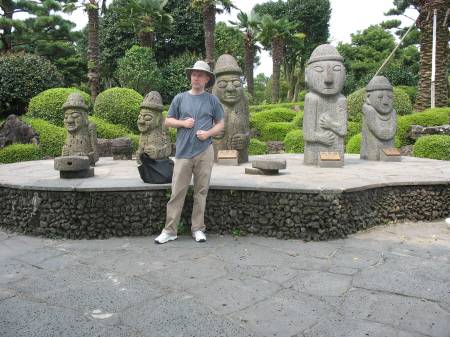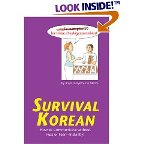The bus’s next stop was a traditional Jeju Island village. Korea is big on traditional villages, but this one hit us in the gut: the guy who showed us around actually grew up in that very spot, and still lived there (unlike these guys, cute as they are).
The only western analogy I could come up with would be a traditional Native American village, in New Mexico maybe, where the locals show tourists around and tell stories.
One of the amazing things about Jeju Island are the Harubang — that means “stone grandfathers” — that are all over the island. These were carved from lava rock several centuries ago, and remind me of the statues on Easter Island.
There are only a few dozen of the original statues left. Two of them were in this village.
Like Easter Island statues, the Jeju harubang all have a particular look. Big eyes without pupils, an unlikely-looking derby-style hat, and hands on the abdomen, one over the other.
The harubang have become a symbol of pride for Jeju Islanders, and copies and images of the statues are everywhere — outside shops and restaurants, on packaging… you can even buy little harubang keychains and cell phone charms.
(By the way, has the cell-phone-charm craze reached America yet? If not, it will.)
Oddly, there are two more iconic characters of Jeju Island, besides the happy “stone grandfather.”
Another are the Jeju horses. They probably aren’t that different, biologically, from your everyday horse, but according to Jeju legend (started, perhaps, by those guys carving those statues), horses from this island have six eyes.
One on each leg, you see, along with the regular two. Don’t bother to look for them… they just sense infrared and help the horse navigate rough terrain at night.
It’s almost believable, for being utter balderdash.
Our village guide seemed to believe it… although it was difficult to judge, since we couldn’t understand a word he said (he spoke Korean with a thick Jeju accent, and the mom who was translating for us couldn’t understand him very well).
The third icon and symbol of Jeju pride are the haenyeo, or haenyo. These are the “mermaids” or woman divers of the island.
Okay, so freediving off the coast for abalone and sea cucumbers and other tasty bits isn’t that shocking for temperate or tropical coastal and island cultures. They hold their breaths for two minutes, yada yada. Like farming, sort of, but under water.
What’s odd is this: A couple of centuries ago, the men stopped diving, and the women took over. I never learned why this happened (if there had been any bloody English, I might have).
These women are imbued with this extraordinary lifestyle. They start at age seven, and since it transforms their bodies — they are amazingly tough and in great physical condition — they continue diving into old age.
And now the melancholy part. The modern young women of Jeju are not following in their mothers’ footsteps (would you?). Like other Koreans, they are going to university and pursuing modern careers. So the haenyeo are dying out.
Anyhow, after the Haenyeo Museum, the bus rolled on and our cool tour bus driver played a movie based on the life of a Haenyeo, “My Mother the Mermaid” to keep us entertained. (Of course, the movie is in Korean, but subtitled in English). Cave video next, I promise.
(If Seattle to Seoul isn’t exciting enough for you, check out the typhoon that hit Jeju 11 months previously.)






